Interview with Gwen Trutnau
By Christina Battle
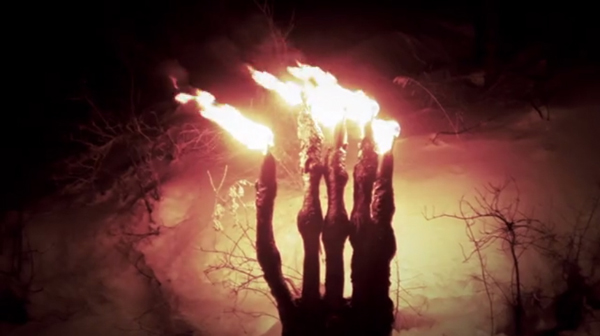 Counter Culture Complex / Gwen Trutnau and Ryan Simmons
Counter Culture Complex / Gwen Trutnau and Ryan Simmons
I first encountered Gwen Trutnau’s work without knowing it, through the music video for Counter Culture Complex (2013) by the Winnipeg hardcore metal band KEN mode, which Trutnau co-directed with fellow Winnipeg artist Ryan Simmons. Although it contained some of the hallmarks of the genre, Counter Culture Complex was unlike any traditional metal music video I had seen before. I instantly knew there was something different about it.
Later, while in Winnipeg for the 2013 WNDX Festival of Moving Image, a number of people mentioned Gwen’s work to me and how much they thought we’d have in common (she was in Montreal during my visit, installing her Even Lower Astral Entity [2013] at POP Montreal). Thanks to Mike Maryniuk, I left Winnipeg with a DVD compilation of her recent projects. When I got home to Denver I was blown away by what I saw. Her works, often shot on Super 8 with dark and doomy overtones, contain a raw, infectious energy that you don’t often see in experimental films. Pulling from the genres of horror and science fiction, Gwen works tirelessly to build intricate sets and costumes while continually referencing the subcultures of metal and punk. Changing the typical constructs of these genres by placing female characters in positions of power and control, her works are inherently political. And always Fucking Kick-Ass!
This interview was conducted over email during the fall of 2014. Most of the films discussed can be viewed on Gwen’s Vimeo page at: http://vimeo.com/user8642480
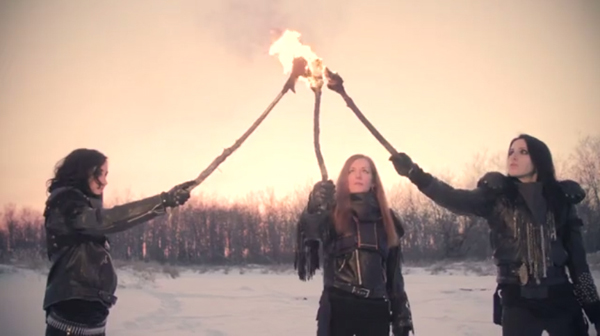
Counter Culture Complex / Gwen Trutnau and Ryan Simmons
Christina Battle: Can you talk about the relationship music plays in your work? Many of your films contain kick-ass metal, offering more than accompanying soundtracks but also influencing the pace and imagery of the works themselves. I’m curious about what comes first for you – the music or the images?
Gwen Trutnau: Music almost always comes first. I only really started making films to be able to put images to the music I was into. I like to listen to a song or piece of music and imagine the imagery. I put on headphones, listen to the piece repeatedly and the images and visuals reveal themselves to me. This works well when I'm making a music video; things get more complicated when I create my own soundtracks. That's something I've been trying to do more of with my personal film and video work. Heavy music and strong images really do it for me.
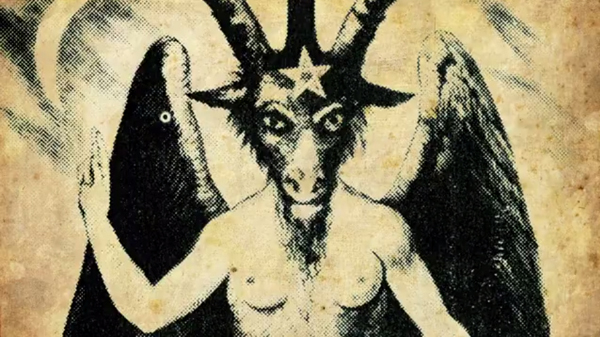 Counter Culture Complex / Gwen Trutnau and Ryan Simmons
Counter Culture Complex / Gwen Trutnau and Ryan Simmons
CB: Counter Culture Complex contains a lot of imagery that we associate with black metal: blood; skulls; fire; demons; references to rituals; Baphomet and other Satanic imagery. But your video flips the typical metal narrative, with three strong female characters moving across the work.
GT: There are many ritualistic images in the Counter Culture Complex video. I really enjoy symbolism and all things occult. The video was a total homage to old school horror and metal albums. The female characters emerged from a theme that I've had in mind for a long time – three really tough women with weapons, living on the tundra with a demon. The viewer isn’t quite clear if they are hunting or being hunted. It was important to me that they had weapons and an assertive role in the video; too often women serve an “ornamental” role in music videos. The last scene with the flaming arrow is very powerful and ultimately symbolizes survival. I had a fantastic time building that leather armor and gearing the women up for the shoot.
CB: The work is also noted as being a collaboration with Ryan Simmons. How does collaboration work for you and what did it mean for this particular project?
GT: Ryan and I have collaborated on a few videos. He comes from a more technical background, which works well since I'm all visual (concepts, design, etc). Collaborating allows me to get lost in the look of it all. This video was shot outside at night in the dead of winter on a frozen creek and in the woods. There were many challenges and it was a tough shoot, so sharing responsibilities was essential. Everyone worked so hard and really went beyond what should be expected on a low budget music video. It was memorable.
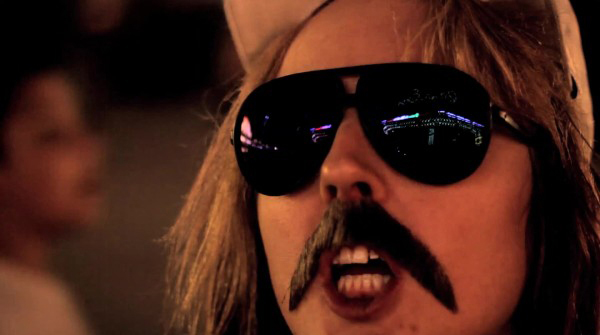 Polar Express / Gwen Trutnau and Karen Asmundson
Polar Express / Gwen Trutnau and Karen Asmundson
CB: Was your collaboration with Karen Asmundson on Polar Express (2014) similar? Can you talk about the process of making that work? It looks like it was super fun!
GT: Working on Polar Express and collaborating with Karen was a great experience: a whole summer of going to the Red River Ex (Winnipeg Summer Carnival) with Karen dressed in her “Jim” character (the protagonist of Polar Express). I ruined more than one take by laughing and shaking the camera around. Shooting in public is a real challenge; you never know how people will react. The threat of being kicked out for guerrilla filmmaking was always a possibility. Karen and I have a pretty similar sense of humor; the fun factor was through the roof. I hope we make part two someday.
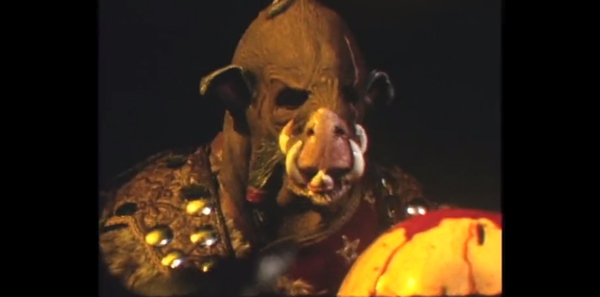 Beast Feast / Gwen Trutnau
Beast Feast / Gwen Trutnau
CB: It’s clear from your work that you spend a lot of time on production planning and building sets and costumes. In Beast Feast (2009) a number of demonic and mythically dressed characters sit down at an elaborate table to partake in a dark ritual. Do you have a script for works like this? With such elaborate sets and costuming, are the narratives rehearsed beforehand, or does improvisation happen while on set?
GT: I really do get wrapped up in sets and costuming. I don't think I've ever shot a film without some degree of design or fabrication. Beast Feast was a Super 8 film that I put together with my sister Claire. Claire and I are huge Dark Crystal (1982) fans and this was our loose homage to the feast scene in that film. I don't think we rehearsed or had a script; we just shot as it happened, as we went. I think I had a few ideas written on a scrap of paper, but we lost it very early on. While filming, people started showing up at different times throughout the evening. We would throw a costume on them and just add them into it... a total improvisation.
I'm lucky to have friends that are willing to do this stuff. The circus of it all is what I find fun. I always say: if it's not fun to shoot, why do it? I enjoy building a set, a new environment, and throwing people into it. This is where the magic begins: With a table full of actors and friends, not knowing what will happen, and each person infusing their character with their own sensibilities and logic. This is why filmmaking, for me, is such a collaborative artform.
CB: This method sounds interesting to me – I like the idea of placing people in scenarios and just going with it. What I also find interesting about your work is that it doesn’t look like it was made that way: everything feels so thick and full; so planned. The sets and costuming (especially with Beast Feast) feel so complete. I think a lot about the different stages of making and how many of us choose to focus on one part (‘cause it’d be fucking crazy and impossible to do it all!) and I wonder if for you, focusing on costumes and sets is the control in a way. The thing that is predetermined, and that giving the other things (script, narrative) over to chance or spontaneity is a perfect pairing to the immense labor and planning you do when it comes to set design?
GT: Yeah, I love the process of leaving some things to chance. It's nice to hear that it comes off as complete; I'm certain there was duct tape and pins holding the sets together in Beast Feast. It would be so overwhelming to focus heavily on every aspect. I always overextend myself and make myself sick on these shoots. I’m trying to learn to let some things go. I think my intense focus on the look of it all is where I'm most comfortable. I'd like to try to make a minimalist film with more of a story, but it scares me a bit! Without the complex visuals I’m sure I’d look through the lens and break out into a cold sweat.
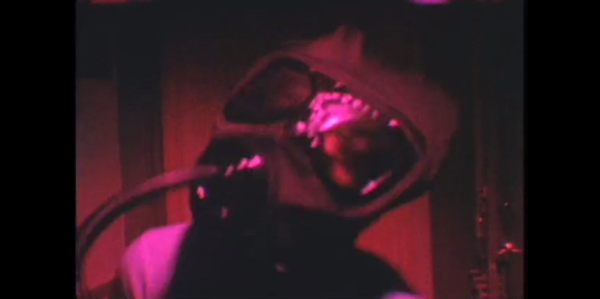
GG Told Me / Gwen Trutnau
CB: A number of your works have been made as part of The One Take Super 8 Event. [1] Can you talk about how this influences your way of working? In GG Told Me (2007), for example, the hand-held, lo-fi look of the Super 8 really affects the work’s overall texture. The film includes a number of images re-photographed off of a TV set – most strikingly a Satanic ritual performed by Anton LaVey. How does the Super 8 format dictate some of your more practical movie-making decisions?
GT: The One Take Super 8 Event was my first foray into filmmaking (Worked To The Bone, 2006). There are some unique challenges to making a film in this manner: you have to edit in-camera, and you don't get to see the work before the public screening. These limitations allow you to do things you might not otherwise, if given the chance to review what you shot. It's an open and free form of filmmaking that is also full of restrictions. I think it really pushes people to try new things.
GG Told Me was made at the last minute – I think it was shot the day before the deadline. I was in a phase of watching a lot of GG Allin backstage footage and revisiting my horror VHS collection. The Anton LaVey footage was from a VHS anthology I own called The Occult Vol 2. I tried to have some semblance of a plan for this one, but it just ended up as what it looks like, shot off the TV. I like the look of lo-fi, shaky security cam footage, and basement home movies. It's ugly to some, but I think it has aesthetic merit as well.
CB: The influences you mention really come through for me on this piece (GG Allin, Anton LaVey, horror movies). The film reminds me of what it feels like to be in a DIY space, and part of a DIY punk/metal scene. It’s messy, it’s fast, it moves around and constantly changes without warning. In a lot of ways Super 8 is the perfect medium to help relay this sensibility. Even the history of Super 8 making (and early video) falls into the DIY ethos – it is the perfect recorder of the underground. Are there other filmmakers you look to or find similarities with when it comes to your work? I also have to ask about Kenneth Anger, as I see a sort of kinship with some of his films in yours. Specifically Invocation of my Demon Brother (1969): beyond its shared interest in the Occult, its hand-held camerawork and image layering seem mirrored in your works.
GT: I've always thrived in all things subculture, and have a strong affinity for anything that has this ethos. I continue to spend a lot of time going to shows in Winnipeg. I'm sure it has influenced my work not only in a visual sense but definitely with the music I choose to complement the films. I love old band footage; I could watch that stuff all day. I have a pretty healthy VHS collection of it.
I certainly consider Kenneth Anger to be an influence. I love Puce Moment (1949) and the accompanying soundtrack. I really love J.X. Williams (The Virgin Sacrifice, 1969) as well. I'm fascinated and mesmerized by his work.
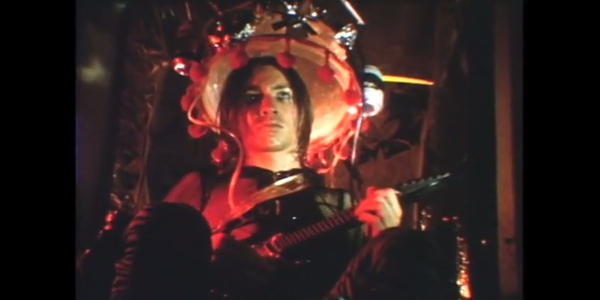 Brodeo in Space / Gwen Trutnau
Brodeo in Space / Gwen Trutnau
CB: In addition to GG Told Me, Brodeo in Space (2008), Beast Feast, and Worked to the Bone were also originally made for the One Take Super 8. When I saw them the first thing that came to mind were some of the restrictions imposed by the event, yet you still incorporate elaborate sets (Beast Feast, Brodeo in Space) and tricky choreography (Worked to the Bone) into the works. Can you talk more about how the event’s restrictions influence the way you make things?
GT: I have now made eight One Take Super 8 films – for years it was the only time I would make a movie. There are many things that can go wrong, and I've certainly experienced a few of those happening while watching the films premiere with an audience. The in-camera editing is difficult at times and not being able to review your work is terrifying as well!
I try to make sure that there are three different set ups. The sets and costumes are really important to me. I like details. It's less about the story for me and more about capturing the weird tableaux that I create. I think that's what drives me to make films: I want to make moments that are scary or beautiful or funny and strange.
I think the One Take Super 8 Event molded my way of thinking about film. I'm still struggling with what I think about digital media and kind of wish everything looked like it was shot on Super 8 film. I like that you only have one chance to shoot a scene; as soon as it’s done you are forced to move on. Kind of like film roulette. The results are permanent.
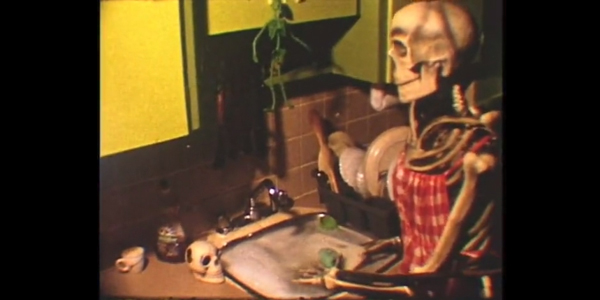
Worked to the Bone / Gwen Trutnau
CB: I also wondered about the community aspect that the One Take Super 8 Event has helped to shape in the Winnipeg film/video scene. At the screening I attended (in 2013) there were 28 works made for the night and close to 100 people in attendance. It clearly holds an important place in your community and I sensed a (healthy) bit of competition at play. How do you think the One Take has influenced filmmaking in Winnipeg?
GT: It’s such a fun event. Everyone is nervous / scared / excited; it's like going to a concert. It’s a real event, there’s an electricity to it that you don’t get going to a movie theatre for a regular screening.
The community aspect, camaraderie and healthy competition are invaluable in a smaller city like Winnipeg. Most of us know each other, so it’s a chance to get together and have a beer and just watch all of these amazing and brave films. I really can't say enough good things about it. It's the reason I tried to first make a film. It's a supportive and fun environment; we are all in the same boat, writhing in our seats with anxiety, hoping the thing is in focus. There should be more events like the One Take Super 8.
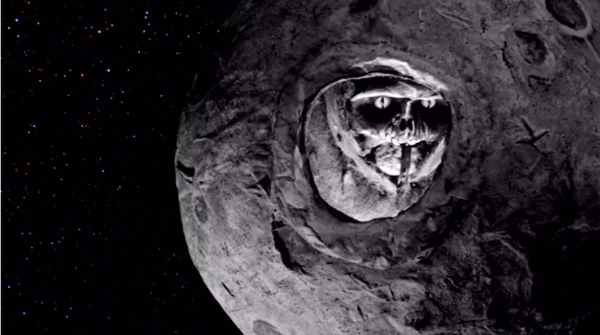
Even Lower Astral Entity / Gwen Trutnau
CB: Can you talk about Even Lower Astral Entity (2013)? I can see the connections between this piece and your earlier work but it also seems like a departure. The soundtrack, for instance, is much more layered. Also, how your approach to making this work may have been different from others?
GT: The soundtrack was actually something I played and recorded with my friend Frazier Runciman (aka Fanny) and my sister Claire. I did this the year before on Lower Astral Entity (2012) and it was really great to make my own soundtrack. It seemed like the perfect way to put my signature on the film and explore how a soundscape works. We ended up layering many tracks when we were editing the film and it came out really strange, in the best way.
CB: Even Lower Astral Entity was presented as an installation at POP Montreal in 2013. Can you describe how the work was exhibited? Were there other elements present in addition to the video?
GT: This piece was a single channel installation for POP Montreal’s EVP* Project: Voices from Beyond (*Electronic Voice Phenomena). [2] I knew the video was going to play on a loop in a small room, almost like a closet, that I put one chair into. Oh yeah, I also put up a poster of a cat. Again I spent many hours building sets, costumes and creatures for this one. The little character in the moon is the narrator. I fabricated him and his moon home and a creature with tentacles and a tree face. I wanted to have fun building things for the film. This was my first foray into installation, and I wanted to showcase some of the creatures that exist in my head.
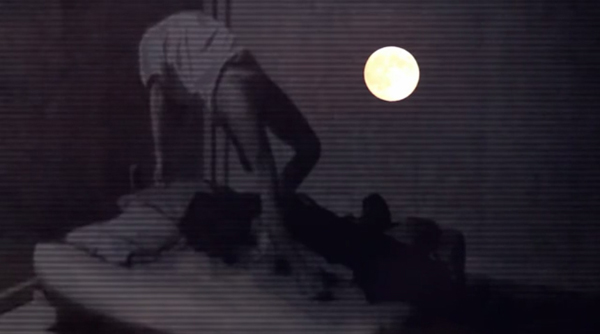 Even Lower Astral Entity / Gwen Trutnau
Even Lower Astral Entity / Gwen Trutnau
CB: Even Lower Astral Entity takes on a number of supernatural phenomena. I wonder if you could provide a bit more information about some of them. For instance: electronic voice phenomena; reptilians; human levitation.
GT: This project was a perfect match for me! It was an honor to be included with so many like-minded artists. Electronic voice phenomena was the main theme of the project, which was curated by Kier-La Janisse. She always puts together the most amazing projects and is such a force as a programmer.
EVP recordings are ghost voices, a paranormal phenomenon, where spirits speak or communicate through electronic static, among other things. I'd been watching Peggy Kane's YouTube channel for years about her EVP recordings with reptilians. The reptilian subject has long been a source of interest to me. The concept of an ancient race of reptoids living amongst us, and traveling through dimensions is so amazing. The whole human meat locker on the moon and subterranean base camps took a place in the piece I created.
There are many schools of thought on this subject, many variations of the reptilian myth/fact. I chose to include images of levitation because they terrify me. They remind me of a scene from The Exorcist (1973) that I saw as a child and that still really affects me. It also reminded me of these weird games my friends and I would play when we were kids: we would all huddle around someone and try to collectively “will” them to float off of the ground. I spent so many hours focusing on metaphysical and occult things as a child. I guess I never quite got over it.
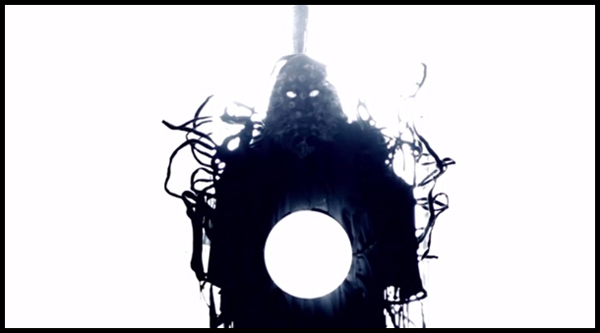
Even Lower Astral Entity / Gwen Trutnau
CB: In a radio interview you did on Cineflyer (CKUW, September 22, 2014) before the 2014 WNDX Festival, with regard to some of the supernatural phenomenon driving Even Lower Astral Entity, the interviewer asked you: “so is this stuff you believe in?” I really loved your answer: “um, I’m really interested in it so I can’t really say. If I think they’re among us or not. But I’m extremely interested in learning more so I can’t really say: Yeah. For sure.” I get asked that same question all the time because of some of the supernatural phenomena I investigate with my own work and I often think it’s the wrong question (whether I BELIEVE or not). I’d love to hear your thoughts about this. You seem to evade the question in a way I find familiar.
GT: I agree, I don't think we are supposed to fully understand these phenomena. The unexplained and the unknown should remain that way. I certainly spend a lot of time studying these things and have come up with no concrete facts, but that must be why I continue looking and wanting to learn more. The film is really the visual equivalent of my research and fascination, rather than attempting to present a complete history of the phenomena. It’s almost as if I am filtering my research into a new unexplained myth. Mysteries are beautiful to me.
NOTES
1. The One Take Super 8 Event began in Saskatchewan in 2000 with 20 filmmakers each shooting a single reel of Super 8 film, which then premiered to an audience without the filmmakers seeing their work beforehand. All the films were shown as shot. No cuts. No splices. The popularity of this non-competitive festival has allowed it to return each year with more filmmakers participating. To date over 750 films have been created for the One Take Super 8 Event in chapters across North America. Run by Saskatoon-based Alex Rogalski, the One Take has been presented in Winnipeg since 2005 via the WNDX Festival of Moving Image.
2. For VOICES FROM BEYOND: THE EVP PROJECT, created specifically for the 2013 POP Montreal festival, ten female media artists were commissioned to make a film or installation addressing the concept of Electronic Voice Phenomenon.
Published January 5, 2015
ABOUT THE AUTHOR
Originally from Edmonton, Alberta, Christina Battle is currently based in Denver, Colorado. Her works are often inspired by the role of non-official archives, our notions of evidence and explore themes of history and counter-memory, political mythology and environmental catastrophe. A contributing editor to INCITE Journal of Experimental Media, Christina also co-curates & organizes the media arts exhibition series Nothing To See Here in Denver.
